PI-009: Seed Potato Tuber Inspection
Appendix 5: Scab
This page is part of the Guidance Document Repository (GDR).
Looking for related documents?
Search for related documents in the Guidance Document Repository
5a: Powdery Scab
Causal agents:
Powdery scab is caused by the fungus Spongospora subterranea, which may survive for many years in the soil as resting spores. The fungus attacks roots, stolons, young shoots and tubers of the developing plant, and may penetrate tubers through lenticels or wounds. It is generally spread by planting infected tubers, moving or spreading contaminated soil or manure. Motile spores of powdery scab can also vectors of Potato Mop Top Virus (PMTV).
Powdery Scab symptoms initially appear on young tubers as purplish-brown sunken lesions, developing into faintly brown raised areas which occur singularly or in patches. Within approximately one week, under ideal conditions these areas enlarge to about 6 mm. When mature, these pustules become yellow-brown to black. At harvest and in storage, the pustules dry and break down leaving circular to oval pits which are filled with brownish spore balls. Sometimes these pits can enlarge to form cankers in the tuber, in which a dry sunken rot may develop.

Description for photo 13
This is an image of the initial symptoms of powdery scab which is caused by the fungus Spongospora subterranea. You can see the purplish brown sunken lesions on the surface of the yellow potato. The lesions appear to go slightly deeper than the surface of the potato and are relatively small in size.
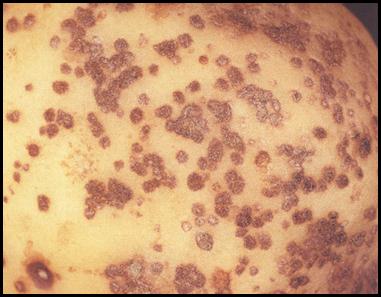
Description for photo 14
This image shows the development of brown raised pustules, a symptom of powdery scab. The yellow potato in this image is covered in small reddish-brown spots, due to some of the pustules close proximity to on another they appear patch-like.

Description for photo 15
This is an image of enlarged pustules on a yellow potato. They appear brown and are raised significantly over the surface of the potato. The pustules seem to resonate in close proximity to one another and look enlarged to about 6 mm in size.
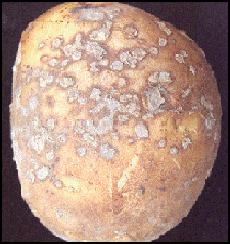
Description for photo 16
This is an image of a potato with pustules that have burst and released spores. The pustules span approximately 60% of the visible potato. There are circular to oval pits that are filled with greyish, brownish spore balls in the place of the pustules. The edges of the pits appear rough and flaky.
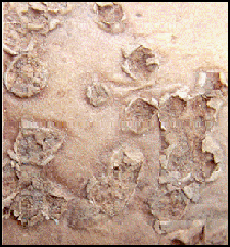
Description for photo 17
This is an image of ruptured pustules on a brown potato. You can see the dry, flaky edges of where the pustules ruptured leaving in its place a slightly darkened pit of dry sunken rot. The pits are located closely together, and at times, forming one large patch of sunken pustules.
5b: Common Scab
Common Scab, Surface Scab, and Russet Scab are all caused by common soil bacterium, Streptomyces spp. which may survive in the soil for long periods of time even in the absence of potatoes. The bacteria are generally spread in the same manner as Powdery Scab by planting infected tubers, moving or spreading contaminated soil or manure. The strains which cause scab infections produce a toxin which results in the formation of lesions on the tuber. Initial symptoms are small reddish-brown lesions around the lenticels of young tubers. In ideal conditions, the lesions increase in size, turn dark and form circular scabbed areas that are either isolated or in large corky masses. They may be superficial spots or greatly roughened blotches. The scab will appear as both smooth and rough, or may be cracked.
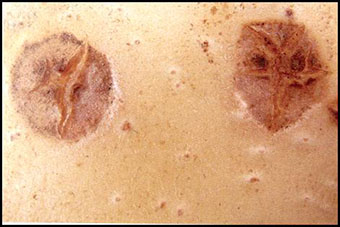
Description for photo 18
This is an image of two initial reddish brown lesions on a yellow potato. In the image the lesions are magnified in size. This makes the detail of the lesion more evident i.e. you can see a crack emerging from the centre of the lesions (in the case of the second lesion multiple cracks).
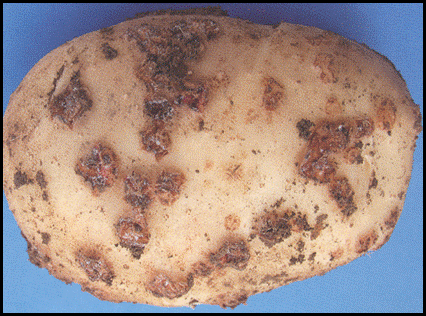
Description for photo 19
This image is of a yellow potato with severe scab. The potato's surface is 40% covered in small reddish-brown scabs that are found in close proximity to one another. The scabs appear flaky with pieces easily coming off.

Description for photo 20
This is an image of a brown potato with deep lesions (Pitted Scab). The lesions penetrate deep into the potato. The potato looks dry and rough with the edges of the lesion peeling and curling inwards. The lesions take up a great portion of the potato leaving minimal surface unaffected.
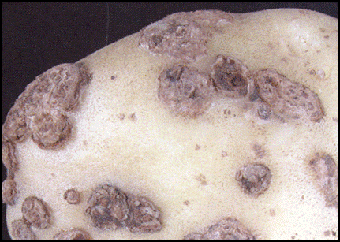
Description for photo 21
This is an image of raised corky, brown tissue on the surface of potato. It appears to emerge from the white potato's surface and looks dry with a bark-like texture.

Description for photo 22
This is an image of net-like scab lesions. The scab lesions cover approximately 50% of the visible potato. The brownish, dry scabs are closely placed for the most part giving the appearance of one big scab. The scab appears rough in texture.
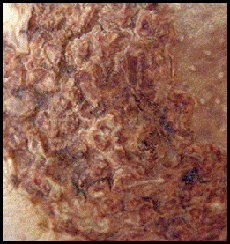
Description for photo 23
This is an image of severe lesions on a yellow potato's surface. It appears red and raised with a rough texture.
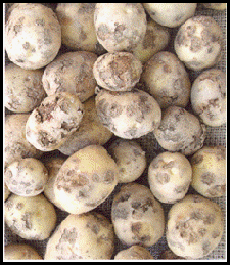
Description for photo 24
This is an image of an extensive scab on tubers. You can see many brown potatoes with deep lesions affecting a good portion of each potato - at least 40%. The deep lesions appear to penetrate well into the potatoes.
5c: Scoring
Scoring:
For tuber grade tolerance, Scab is treated in the same manner and under the same tolerance as Rhizoctonia. The total amounts are combined under the same tolerance when both diseases are present. In general, all Scab is treated equally for domestic and some export destinations depending on their current import requirements. In order to approximate the percentage coverage of the tuber, the surface can be divided into three dimensional quadrants as illustrated below (25); each half of the tuber represents 50% of the surface area. The size of quadrant the lesions would occupy if all lesions were pooled into a single area of the tuber will help to determine the disease level for scoring purposes. Examples of trace to severe coverage, based on the exposed side of the tuber, are given below (26).

Description for photo 25
This image is made up of three pictures of the same brown potato. The first picture shows a potato with approximately 22 scabs. The second picture shows the same potato where the scabs have been digitally cut out of the picture leaving the rest of the potato in the picture. The third picture shows the cut out scabs from the picture superimposed on a silhouette of the potato. The scabs have all been grouped in the top left hand corner of the silhouette to show that they cover 12.5 % of the surface area.
| Disease Level | Percentage Coverage |
|---|---|
| Trace | 0% - 1% |
| Light | >1% - 5% |
| Moderate | >5% - 10% |
| Severe | >10% |
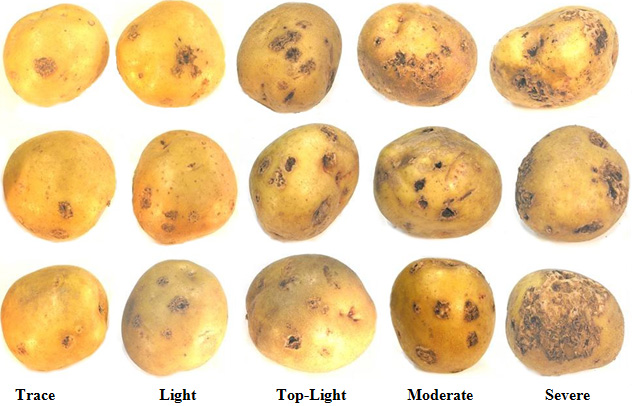
Description for photo 26
This image shows 15 tubers arranged in five columns of three potatoes each. The potatoes in the first column all show trace amounts of scab; the second column shows potatoes with light scab; the third column shows potatoes with the top end of light scab; the fourth column shows potatoes with moderate scab, the scabs are in a higher frequency and in closer proximity to one another. The fifth and final column shows potatoes with severe scab, the scabs cover a large portion of each of the potatoes.
- Date modified: